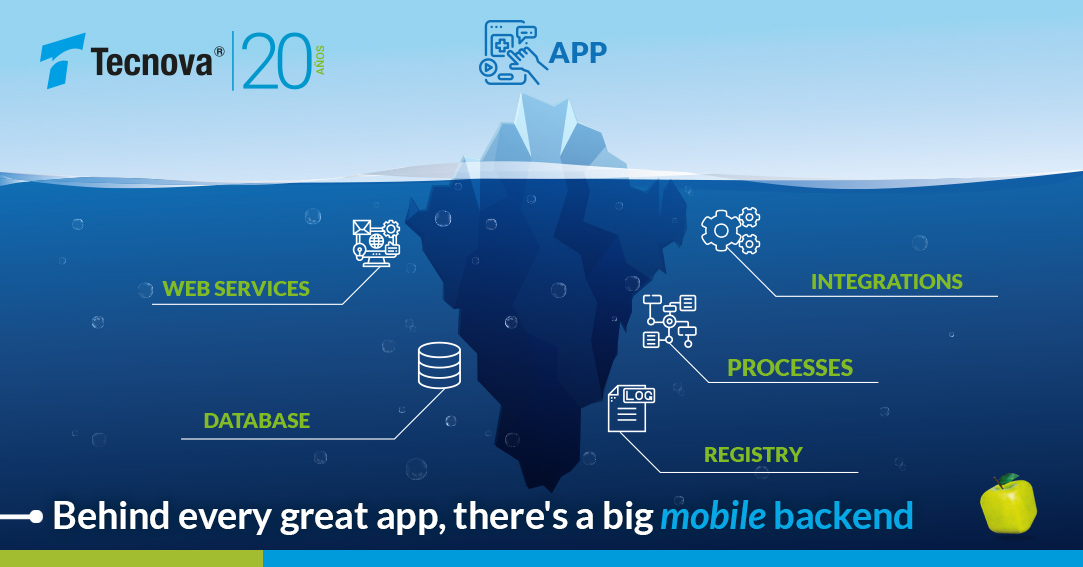Behind every great app, there’s a big mobile backend

For every great application to work, it needs to have a great mobile Backend. For people who need to create a mobile app to start a business or service, they certainly haven’t heard this concept. However, it’s very important to know when developing mobile apps. Why?
Let’s start by understanding what a Backend for a mobile app is. According to Owius, the mobile backend is the “webservice engine or system, which centralizes all requests that are made from mobile devices that need to do write operations, data collection from a database, calculations, logs, shipments, etc.”
The backend solution should host an entire data ecosystem and future actions to be executed that will be requested by users in the application.
Backend depending on where the app is hosted
To create this mobile backend, it will depend on where the app is hosted. That’s why customers can choose to develop an on-premises application or a cloud-connected app.
- Local apps (e.g. Apps that only operate inside and by the company): no interaction between the data server and the client. Application modifications (content, updates, etc.) are made by republishing and updates by the mobile developer.
- Cloud-connected applications: Full connectivity to the application server and users, as well as between the same users. It allows community interaction, sending push notifications, live data, etc.
The latest option is usually the most used. For Apps Panel, this type of cloud development is for providing information to users (such as geolocation, for example).
To fulfill that purpose, applications must cross-reference their internal information with other databases. The content of mobile apps therefore interacts and is updated on the “cloud” servers.
Applications that develop their cloud backend are commonly known as BaaS or mBaaS or Backend as a Service.
Backend as a Service trend
A BaaS or mBaaS or Backend as a Service is a platform that automates the development of the backend and takes care of the cloud infrastructure. When developers use a BaaS, it “outsources” the responsibilities of running and maintaining servers to a third party.
Thus, as stated in Medium, “it is a model that gives web and mobile developers a number of services allowing them to completely do without a custom API”. In addition to this, a BaaS will provide a set of tools to help the developer create the back-end code and speed up the development process. Some of its functions are data management, consuming third-party APIs, social networks integrations, file storage, push notifications, among others.
According to engineer Adrián Alonso, some of the benefits of BaaS are: Cloud Storage eliminates the costs of an application server, analytics services, authentication, push notifications and Realtime (allowing to develop functionalities such as chats, video games).
Factors to create a successful mobile backend
Independently of the option that the customer chooses, it is essential to generate a backend for the optimal operation of an app. Therefore, the Hiberus site has compiled a number of factors to develop a successful application. Here, a few brief elements to consider.
Authentication and security
For example, two authentication systems are used today: a traditional login/registration, or one that relies on the use of social networks (Google, Facebook, Twitter, etc.).
The author of the note suggests that it is more convenient to opt for the first option (if it is correctly implemented). This is usually the most scalable way in the long run, since we will have full control over the data and, therefore, the architecture of the app.
Scalability and speed
From Hiberus they suggest that “a backend that takes a long time to respond will not scale properly” and/or will cause the application or service not to meet the demands of modern users. Therefore, it suggests implementing a stateless backend, that is, that, in each task request, it must include the information needed only to resolve that particular request without requiring server-side session variables.
It also suggests applying the separation of its functions in Microservices on the same backend. For example, if the mobile app is the party responsible for registering a user to receive push notifications and sending them, it is suggested to create a microservice to comply with it.
Stability and future-proofing
Ensuring the stability of the application is a priority against possible problems of the app. If one exists, the main thing is to find out the cause of the problem, fix it and get our backend back up and running. The website suggests that, to do so, “we need monitoring tools, continuous integration, automatic deployments and a ‘code quality’ will minimize the risks.”
As we suggest from Tecnova, if we want to develop a mobile or web application that is optimized and fully operational, we must create a scalable and monitored architecture for troubleshooting such an app. To do this, it is essential to create a good mobile backend, with solutions in middleware and apification.








